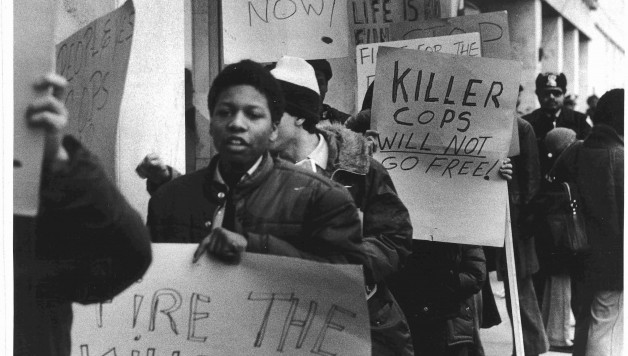Letter to Bayard Rustin
by Narayan Desai

Demonstrators protesting peacefully, Harlem, July 1964; photo courtesy newyorknatives.com
Editor’s Preface: The background for this letter is the Harlem riots of July 1964. A fifteen-year old black youth, James Powell was shot three times by a white police officer, the second bullet killing him. Powell was standing at the time in the midst of a group of friends. There were at least a dozen witnesses; his death sparked six consecutive nights of rioting, spreading that summer to several other cities such as Philadelphia and Chicago. At the time of writing the letter Desai was acting secretary of Shanti Sena, which he’d helped to found, and Bayard Rustin was one of the most eminent leaders of the U.S. nonviolence movement. The letter is dated, 6 August 1964, when the riots were still raging, and was sent from Mandal Rajghat, the Shanti Sena headquarters in Varanasi, India. Please see the Reference and Editor’s notes at the end for further information and acknowledgments. JG
My Dear Bayard,
I have just read with great interest reports about the Harlem riots in Newsweek and Peace News. The Newsweek report gives more information while the Peace News article poses certain problems. Before giving my comments on the problems posed in Peace News, let me express my heartfelt congratulations for the part that you and James Farmer played during these incidents. You must have received many letters of congratulations for the Washington March as it was an obvious success. But a peace worker alone knows how greatly he needs to be congratulated for an effort where he has not achieved such clear-cut results. I really think you have done a great job at Harlem.
It is interesting to note that you are entering a stage in your movement where from clear-cut and specific issues you are turning to problems pertaining to the change of the whole social order. This certainly is the time to ponder over methods and to endeavour vigorously to find new, positive and dynamic methods.
The following extract from A. J. [Muste] in the Peace News is most interesting: “To urge that the emphasis now be on further developing a nonviolent strategy rather than abandoning or diluting it, is not to urge retreat or moderation or reducing the militancy of the struggle. It is meant to be, and in my opinion can be in practice, exactly the opposite, viz., the means to maintain and intensify the dynamism and drive of the integration movement, ”
I do agree with A. J. that emphasis now should be on further developing a nonviolent strategy rather than abandoning or diluting it. But are we quite sure that developing of nonviolent strategy necessarily means increasing the militancy of the struggle? It is likely that A. J. may have a different meaning of militancyin his mind than what I have, but if it means taking your methods more and more towards expressions similar to violent methods, then where are we going to end? I would like to know more about your definition of militancy.
But this is not to discuss words. Let us try to think of some other courses that you can take in the present situation.
The future programme can be divided for convenience into three different headings:
(1) Immediate programme among the Negroes
(2) Immediate programme among the white population, and
(3) Constructive work among both.
1. The immediate task among the Negroes would be to secure the mental balance that must have been lost owing to the riots. “Resorting to violence means voting for Goldwater”, seems to be a good slogan as well as a good argument to me. The self-defeating suicidal nature of violence should be duly emphasised in the post-riots days, when the people of Harlem might be in a more contemplative mood than during the actual riot days.
Programmes giving nonviolent expression to the need of the Negroes of Harlem could also be tried. How about a mass meeting of say 20,000 children singing one really moving song? A powerful song on the tongues of all the children of the area may be a very subtle and effective means of nonviolent action. What do you say about all the women in the area wearing a black strap on the arm for a certain number of days or until some immediate objective is achieved? The enrolment of women in the nonviolent movement is a very important factor. Even nature has made women more suited for nonviolent action. And how about 10,000 people fasting on a specified day? I know that your people are not used to fasting or similar other methods of self-suffering. But were they used to other methods of nonviolent action a decade ago? A novel method may be more attractive to the nonviolent volunteers and more effective upon the public in general.
2. A positive step towards resolving this problem should be taken by working among the white population of New York. It is true that the social problem involved here will take a long time to solve. But there are certain things that must be done immediately. There may be a tendency among some of the unruly white elements to retaliate. Steps should be taken to counteract this. This can be done by keeping an eye on such trouble spots, making house to house contacts there, as well as by general propaganda. The attention of the thinking white can be drawn towards this problem immediately and efforts must be made to rouse the feeling of compassion among them. Could there be procession of white sympathisers to the Negro cause marching through both the areas? Could we appeal to some of the favourably inclined firms to employ more people from the Harlem area? Could we find landlords offering to let their houses to Negroes? There could also be letters and deputation to the Mayor and the President by whites in sympathy with the cause.
3. One of the things that can be added to the nonviolent movement of the U. S. is constructive work [inspired by Gandhi’s constructive programme]. Supposing we start with the rehabilitation of the sufferers in the riots? Here is a field where both the whites and Negroes can join hands. There could be joint work camps of youth organisations. Some of the psychologists and other specialists may be persuaded to work in the Harlem area in order to do the mental rehabilitation work. Some of you might start centres of social service among the people of Harlem. This might give you an opportunity to serve the people, know the people and influence the people.
I know how foolish it is to suggest programmes to a man like you who has an idea a day in the head and I also know how absurd it is to suggest something from such a distance, knowing practically nothing about the conditions there. But still I venture to write, because as a friend I know I can indulge in suggestions, and as a friend I would like to share with you in the days of your difficulties.
With best wishes.
Yours sincerely,
Narayan Desai
Secretary
Reference: IISG/WRI Archive Box 312: Folder 10. We are grateful to WRI/London and their director Christine Schweitzer for their cooperation in our WRI project.
EDITOR’S NOTE: Narayan Desai, (1924-2015) is the son of Mahadev Desai, Gandhi’s chief secretary until 1942. Narayan is the founder of the Nonviolence Training Center, the Institute for Total Revolution, and the author of a four-volume biography of Gandhi among other works. He has been awarded both the Jamnalal Bajaj Award and the UNESCO Madanjeet Singh Prize for his work in nonviolence and pacifism.




